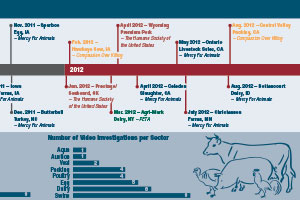Animal protection groups have refined their use of undercover video investigations to effectively bring more public attention to their cause and influence food company policies. Fortunately, the food animal industry has evolved in responding to them.
A cursory Internet search reveals there have been at least 32 hidden camera investigations at livestock, poultry, egg and packing house facilities since 2005. More than half of them have occurred in the last three years – nine in 2012 alone.
There’s no doubting the strategy h 
as been successful for the animal rights movement. Pork has been the most frequent target with nine hidden camera investigations – many focusing on common practices such as housing – targeting hog operations in the last six years. Click here or on image at right to download a PDF of the full size.
It’s no coincidence that so many restaurants and food companies have announced plans to purchase more pork from sources discontinuing the use of sow gestation stalls.
Dairy operations have been targeted six times since 2009, and a fundamental shift in the way the industry is managing these incidents appears to be under way.
Early on, it seemed the industry was reluctant to comment in hopes the issue would just go away. The “see no evil – speak no evil” strategy reinforced a perception that the industry would turn a blind eye to animal abuse in the interest of profit or that it simply didn’t care.
As cases continued to surface, the reaction moved toward condemning the perceived bad actors. Now the industry is using a much more strategic response. This new approach involves acknowledging activities that are completely inconsistent with social and consumer expectations.
Inappropriate animal handling practices highlighted in video investigations can be condemned without condemning the targeted operation. We’ve learned that actively and consistently demonstrating to consumers that dairy farmers share their values is the best approach in maintaining public trust.
The industry’s more strategic, refined approach does just that. We’ve gone from saying nothing and defending the farmer at all costs to becoming a leading voice in the conversation.
The dairy industry is recognizing that we must be willing to condemn practices that can’t be defended – but the industry is also realizing there is benefit in sharing the public’s disdain of inappropriate animal care in a way that protects the integrity of the industry and highlights improvements at the targeted farm.
There’s no doubting that groups are using undercover video investigations to advance narrow agendas, but there’s little to be gained by attacking those who bring the issue to the public’s attention. We should focus on those who matter the most – the people wanting to know that the food they are consuming is being produced responsibly and the people producing it can be trusted.
When consumers see undercover video showing animals being mistreated, it causes them to look more closely at a system of agricultural production with which they have little or no familiarity. They are uncomfortable with what they see because it doesn’t align with their vision of farming.
In many cases, science is on the industry’s side. Some of what is shown in video investigations in recent years demonizes practices that experts agree provide proper care. The challenge comes in assuring consumers the production practices used on modern farms – while not always camera-friendly – are humane, and the people responsible for animal care are genuinely committed to doing the right thing.
Video investigations remind us that the gap between agriculture and consumers continues to widen. We can and should do a better job of bridging the gap and assuring consumers that even though farming systems have changed, the commitment to responsible food production is stronger than ever.
We should work toward increasing the transparency of today’s production systems and, in so doing, reduce the gap between farmers and consumers and encourage a more informed conversation about farming and food.
Having a crisis plan in place is essential in today’s rapidly changing operating environment. But the best defense is avoiding the crisis in the first place. Today, transparency is no longer optional. Everyone who owns a smartphone is a cinematographer.
Today’s dairy farmer should operate as though someone is watching what happens on the farm all the time.Farms are seeing increased value in educating employees on proper animal care and using certification programs that provide assurance to food companies that appropriate practices are being implemented to ensure quality animal care.
A heightened level of public awareness of the issues requires everybody in the industry to be more strategic in their preparation and their response. As the distance most consumers have from agriculture increases, and the level of technology used in farming continues to advance, we must dramatically improve the ability and commitment to build trust with customers and consumers. This requires a new way of thinking, a new way of operating and a new way of communicating. PD
Arnot is a communications consultant with CMA.

Charlie Arnot
Communications Consultant
CMA






